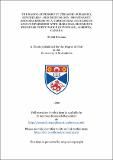The Karoo Supergroup (Triassic-Jurassic), Seychelles : sedimentology, provenance and diagenesis of a terrestrial succession and comparisons with marginal sediments from Elk Point group (Devonian), Alberta, Canada
Abstract
The offshore Karoo Supergroup (+2 km thick) of the Seychelles has been divided into five members based mainly on sandstone/mudstone development as revealed by wireline logs and lithological samples. The four lower members are characterized by thick sandstones with minor mudstones and the lowest member distinguished by the presence of occasional bands of lignite; the topmost member has thick mudstones as well as thick sandstones. Members 2 and 3, and 4 and 5 form two upward-fining megacycles in which members 2 and 4 have coarser-grained pebbly, sandstones while the sandstones of 3 and 5 are medium and fine-grained. The sediments are fluvial in origin, possibly braid plain except for the uppermost member which may have formed under a meandering system. Paleogeographic reconstruction invokes a source area in north-east Madagascar shedding debris eastwards towards the Seychelles which at that time (pre-mid-Jurassic) lay between Madagascar to the west, and India to the east. Burial curves are presented from considerations of sediment thickness and texture, structure, including the positions of unconformities and diagenesis as an aid in assessing oil potential. With possible source rocks in overlying marine sediments, hydrocarbon generation may have occurred in late Mesozoic and early Tertiary. Migration could possibly have taken place into fault-juxtaposed Karoo sandstones. For comparative purposes petrographic features of samples from the Elk Point Group Alberta, Canada were studied. This Devonian sequence comprises marginal and marine sediments including carbonates and evaporites, but the sandstones studied come from marginal deltaic deposits. Sandstones studied are remarkably similar in both original composition and diagenetic history. Primary mineralogy was determined by similar source areas - predominantly granitic with minor metamorphic and volcanic components. Despite being deposited in different sedimentary environments both groups show extensive diagenesis involving dissolution of feldspars and lithoclasts, precipitation of quartz, and a second phase of dissolution of feldspar, lithoclasts and quartz. Kaolinite is the dominating clay in the sandstones of Karoo Supergroup up to depths of 10,000 ft, while illite prevails over other clays in the sequence between 10,000-12,500 ft. Illite and chlorite are present in the Elk Point Group: kaolinite is absent. The last stage of cementation in Elk Point sandstones was anhydrite precipitation during Cretaceous times. Precipitation of authigenic cements ended with the formation of carbonates in Karoo sandstones. Cementation, especially by quartz appears to have considerably reduced porosity in many places in both the successions. In both the study areas early diagenesis was controlled by meteoric waters while burial and marine influence are responsible for later diagenetic episodes. The presence of illite and chlorite against kaolinite in the Elk Point Group is due to greater depths of burial than Karoo sandstones. Presence of evaporitic environments lead to the formation of anhydrite in the sandstones of Elk Point Group, while feldspar overgrowths are formed as a result of retention of pore-fluids due to the formation of a closed system controlled by marine flooding surfaces.
Type
Thesis, PhD Doctor of Philosophy
Collections
Items in the St Andrews Research Repository are protected by copyright, with all rights reserved, unless otherwise indicated.

